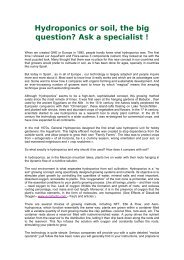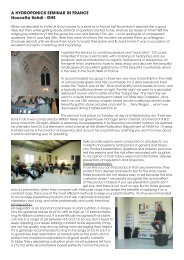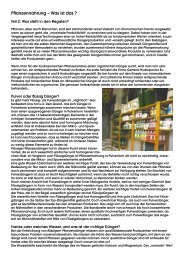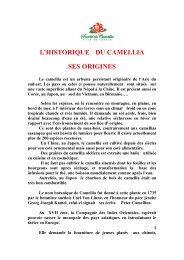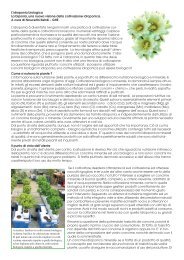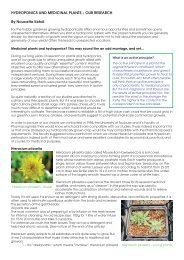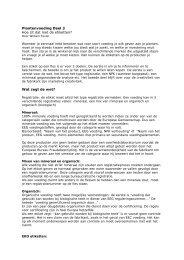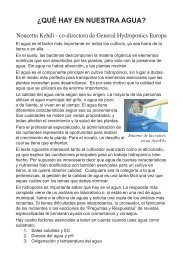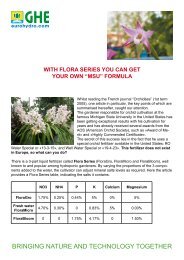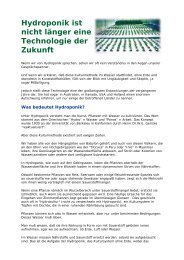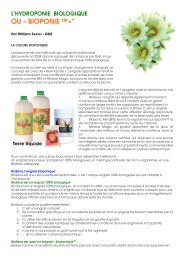FERTILIZERS OR ADDITIVES? - General Hydroponics Europe
FERTILIZERS OR ADDITIVES? - General Hydroponics Europe
FERTILIZERS OR ADDITIVES? - General Hydroponics Europe
You also want an ePaper? Increase the reach of your titles
YUMPU automatically turns print PDFs into web optimized ePapers that Google loves.
<strong>FERTILIZERS</strong> <strong>OR</strong> <strong>ADDITIVES</strong>? First part<br />
By William Texier - GHE<br />
By speaking to our clients or visiting shops, I have come to realise<br />
the difficulties faced by cultivators in differentiating between<br />
a fertilizer and an additive.<br />
However, this difference is both fundamental and simple: A plant<br />
requires variable quantities of mineral salts to nourish itself. Any<br />
product that provides mineral salts, whether it is the primary or<br />
secondary source, or a micro-element, is a fertilizer. This fertilizer<br />
is necessary to sustain the plant and, in hydroponics, is the sole<br />
source of nutrition. If it is a complete fertilizer, not only is it necessary,<br />
but also sufficient, because it provides the plant everything<br />
it needs for its metabolism. Both in theory and practice, you can<br />
have very healthy plants and a rich harvest using a complete<br />
fertilizer on its own.<br />
So why use additives? There are products that have a function other than nourishing the plant. They promote<br />
and accelerate growth whilst improving its general health and resistance to insects and pathogenic<br />
diseases. <strong>General</strong>ly, they either function by providing the plant with ready-made molecules, thus saving<br />
energy which can otherwise be used elsewhere, or they give signals to the plant, increasing its metabolism.<br />
There are several kinds of additives and they often have multiple actions. This article, presented in two sections,<br />
looks at the more common ones on the market today.<br />
Silicate:<br />
In order for an element to be considered indispensable to a plant, there has to be evidence of a deficiency<br />
in the plant caused by the absence of the element. With modern hydroponics, it became possible to create<br />
deficiencies in a plant’s nutrition by isolating one element or another. This is how a list of mineral salts essential<br />
to the plant’s life was established. This test was never carried out on silica, essentially because it is such<br />
an abundant element in soil that it is difficult to create an environment without it. However, there are strong<br />
indications that silica is an essential element.<br />
In any case, it has a number of functions in plants:<br />
In solution, it is absorbed by the plant in the form of silicic acid. It penetrates into the cells and strengthens<br />
their structure. This means they are more resistant to attacks by insects, which find it difficult to pierce into the<br />
cell walls. They tend to go for plants that are easier to attack.<br />
But silica has other advantages: In the nutritive solution it helps to stabilize the pH. It also protects the roots of<br />
pathogenic fungi such as pythium and fusarium by killing their spores on contact.<br />
Silica is found on the market either in liquid or powder form. In the first instance, it comes in the form of potassium<br />
silicate, an effective way of providing silica; however, it is limited by the poor solubility of potassium silicate<br />
in the levels of pH used in nutritive solutions. In the second instance, it comes in silica clay, which is very<br />
rich in silicate and contains a number of useful elements in traces.<br />
This clay can be used externally, in powder, on foliage applications<br />
or around the root, to prevent a fungal attack. It can also be used<br />
internally, in the nutritive solution, to be absorbed by the plant.<br />
Adding silica does not give a spectacular result because it is, after<br />
all, a preventive substance. However, an informed cultivator is<br />
quick to realise that his plants are healthier than usual, that it has<br />
been a long time since they were attacked by insects, and that<br />
the pH is more stable.<br />
Humates<br />
These are a large family of molecules that have similar characteristics.<br />
They are defined by the way in which they are extracted<br />
rather than by a chemical structure. Humates are the result of the<br />
decomposition of organic matter. They are, of course, found in<br />
Cymbidium in full bloom, cultivated in<br />
an AquaFarm with Flora Series, Diamond<br />
Nectar (fulvic acid and humic acids)<br />
and Mineral Magic (silicate in powder<br />
form)<br />
Trichocereus peruvianus: a little Mineral<br />
Magic (silicate in powder form)<br />
to promote quicker healing, and<br />
avoid disease and decay.
the ground. They only represent a small portion of the matter that<br />
was decomposed; the remainder consists of other minerals that the<br />
plant uses for nourishment. The family is divided into three fractions<br />
according to their molecular weight: humic acid, with the highest<br />
molecular weight, ulmic acid, and fulvic acid, a molecule which<br />
has a much shorter chain, but numerous active sites. The chemistry<br />
of humates is complex. More than a million different molecules are<br />
listed in this category. Nevertheless, they have common points with<br />
respect to both their composition and structure.<br />
In fact, humates make up the active element of the soil. When you add them, whether into soil or into a nutritive<br />
solution, you increase the plant’s activity. In view of the aforementioned, it is easy to comprehend that<br />
all the humic or fulvic acid-based products on the market are not the same. This means that the concentration<br />
of the active matter is of no help to us, because the activity does not depend on the concentration, but<br />
on the source of the product! They are often extracted from a rock called leonardite, but not all leonardite<br />
deposits are the same. You have to do numerous tests on the cultures to determine the most effective product.<br />
Their action is incredibly diversified:<br />
First in soil: they increase the water retention capacity, improve ventilation, enhance texture, prevent from<br />
drying out in case of drought, make the soil lighter, and help prevent soil erosion.<br />
On a chemical level, they keep the elements insoluble in the root area; they encourage the conversion of<br />
some of these elements into an easily assimilated form by the plants, then “release” them so that the plant<br />
can absorb them. They have a strong ionic exchange capacity - both anions and cations - which acts as a<br />
buffer in soil as well as in the nutritive solution. They increase the quantity of nitrate in the soil. Finally, they are<br />
rich in organic matters and mineral substances indispensable to the plant’s growth.<br />
Thumbergia grandiflora: cultivated in a<br />
Dutch Pot with Flora Series and Diamond<br />
Nectar.<br />
On a biological level, they stimulate the metabolism, accelerating<br />
cell division and activating growth in the root area. They<br />
increase the germination rate of seeds, facilitate the assimilation<br />
of nutrients, boost microbial life in soil,<br />
aid photosynthesis, increase root respiration<br />
and stimulate enzymatic activity.<br />
This impressive range of actions<br />
boosts the popularity of humates<br />
among gardeners and horticulturists.<br />
Humates are used for watering soil or<br />
are dissolved in the nutritive solution,<br />
but they are just as effective for foliar<br />
spraying.<br />
Subject to finding a good quality<br />
product, humates and particularly<br />
fulvic acid, the most active, are still my favourite for improving the health of plants<br />
and the quantity and quality of the harvest. No other product offers a range of<br />
actions as wide and diversified. Moreover, it is a natural product, one of the essential<br />
elements of soil, and can be used in organic cultivation too.<br />
Humic acid molecule<br />
Roots in AeroFlo, cultivated<br />
with FloraNova<br />
and Diamond Nectar<br />
You will find the follow-up to this article in the next edition of your magazine. If you have any questions or<br />
comments, please do not hesitate to contact us at tech@eurohydro.com




